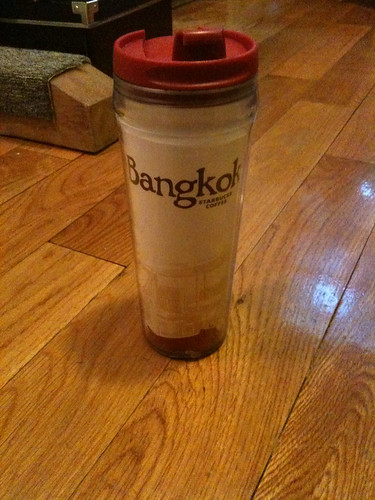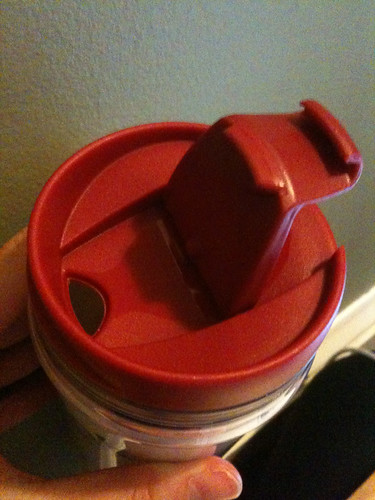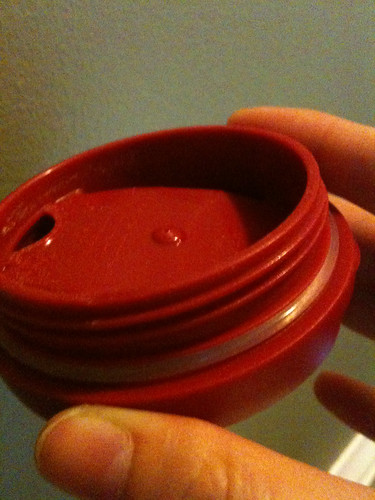Teachers — myself included — are always telling their students that they should connect their learning to themselves, to something the student feels passionate about. We know that this principle is largely based upon constructivist learning theories. It’s no secret that I am generally a constructivist (though I spice things up with aspects from other theories too), so I am taking a constructivist approach to my assignment this week. This week, I’ve been assigned to critique an interface, based on the readings I’ve been doing about design. Frank said we could critique pretty much anything that is an “everyday object” or even wider, to a kiosk or web page. I’m choosing something near and dear to my heart: a coffee travel mug.
If you know me well, you know I have a substantial collection of coffee mugs in my ownership. I don’t collect them for any reason other than because I love to drink coffee, and I love that travel mugs make the drinking of coffee so wonderfully convenient. The mug I’m critiquing today is this one (Fig.1):
Overview:
This travel mug is a standard 12oz. (“tall”) sized mug made by Starbucks. It has a rubber bottom approximately two inches wide, and is approximately 8 inches tall. The base of the lid is about 3 inches in diameter, meaning it has a larger lid than base. (See Fig. 2) The mug’s exterior is made of hard, clear plastic, while the lid is made up of rigid burgundy plastic. Inside the lid, there is a rubber ring around the diameter of the lid where it screws onto the main part of the mug. (See Fig. 3) The lid screws on inside of the mug itself. The lid also has a flip-top with a “lip” made of rubber, a different material than the plastic which makes up the rest of the lid. The rubber on the “lip” is meant to completely close the hole in the top of the lid which would normally be used to drink from. In effect, closing the “lip” seals the container, though Starbucks is quick to point out in the material that comes with their products that they do NOT guarantee their mugs to be spill- or leak-proof.
Mapping:
The mapping of this object is fairly obvious in some places, but less explicit in others. For example. It is obvious where one should put his/her mouth — over the hole in the lid. Likewise, it is also obvious that to control the fluid entering / exiting the container, one needs to move the lid. It’s not well mapped as to where one is supposed to hold the mug, so I assume one is meant to hold it however necessary to get the liquid out of the container and into one’s mouth, which I believe would be the goal (well, it is in my case, anyway!). Thus, experimentation is again needed to tilt, hold, grip, and rotate the mug itself. This is not explicitly mapped, though I have a hard time imagining anyone would find difficulty with it, assuming they have some prior experience with a drinking container of some kind. In that sense, it is intuitive, but it is not mapped.
Affordance:
If affordance is about giving the user an idea or clue of how to use something, then I will say it is less obvious how to “unlock” the lid when it is snapped shut over the lip. The lip protrudes over the edge of the lid, so it is implied that one has to use his /her fingers to pop it open, but there are no directional instructions (words, symbols). Also much less obvious is how to open the lid. There are no arrows or other visual indicators to show how or which way to get the lid off of the main mug. It is only by experimentation or trial and error that one learns that it screws off, in the “standard” way (“righty-tighty, lefty-loosey”). Regarding affordance of what to do with the entire object: while it is intuitive as to what to do with this object, I might say that it has affordance in this respect (ie., it looks like something you are supposed to drink out of). However, as I stated earlier, this is not necessarily well-mapped and relies on the user’s previous experience / knowledge. One who did not have any experience with previous travel mugs, for example, might think that the main mug part of the object could be used as a vase, or a pencil holder. Thus, the design of the product itself does not have any affordances made to make it explicitly clear that this object is solely for drinking coffee.
Function and Feedback:
Considering what the product has been designed for, I think it achieves its purpose in a basic but adequate way. It holds coffee. The lid closes and thus it is relatively good at keeping the coffee inside when it is not being consumed. However, the function of stability is not as well accounted-for as it could be. Because the base is approximately 1 inch smaller in diameter than the top, the mug is not especially stable. This means it is easy to knock over, tip, or not set down properly, which could lead to the tragedy of spilled coffee. Even if the mug lip is closed over the lid, some does leak out if the mug is completely turned on its side. This is despite the design including a rubber ring around the lid and the rubber “stopper” in the lip. Additionally, the container is not insulated and so coffee does not stay warm for long. I might also add that the design is not compatible for rugged lifestyles, as when dropped, the item does crack. (See Fig. 4) This is despite the very firm and heavy plastic used to create the product.
Conclusion: Is this well-designed?
The interface for this mug is fairly well-designed, but it could be better. More specifically, I think this kind of object could be more ergonomically designed to fit neatly in a person’s hand (mapping). Also, I think more affordances could be made in terms of how to unscrew the lid and how to open the lip of the lid. Lastly, I think the design could be improved by widening the bottom of the base. This would prevent more accidents in terms of spillage, which could potentially be dangerous if the liquid inside is very hot.
Last thoughts:
Hmmm, I wonder if hypothetically Starbucks could ever be sued for poor design if the mug tipped over after one had just poured very hot coffee inside and the lip was open because I couldn’t figure out how to close it properly, or the lid not screwed on completely tight?
I’m kidding, of course, but it is food for thought, isn’t it? Is it my fault that the coffee mug is not designed for stability? or that I can’t figure out how to get the lid off?
What implications does design have for things like regular instructional planning and strategies? What about the design of a teacher’s classroom — how the desks are arranged, how the furniture is set up, where the whiteboard or projector screen is? What affordances are you providing for your students? How well-mapped is your project handout?
I have never thought about design in these ways before, but it certainly has got me thinking about larger implications. I’m even now thinking about how I can “re-design” my living space!







